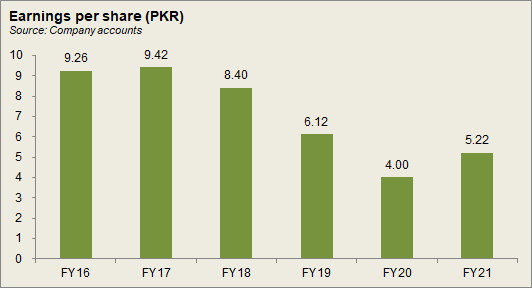Orix Leasing Pakistan Limited
Orix Leasing Pakistan Limited (PSX: OLPL) was established in 1986 as a result of a joint venture between ORIX Corporation, Japan and local investors. Initially it was a private entity but in 1987 it was converted into a public limited company. The company conducts Investment Finance Services as a Non-Banking Finance Company (NBFC). Some of its products include commercial vehicle lease, corporate lease, auto lease, operating lease, micro credit, Islamic finance, and e-business.
Shareholding pattern

As at June 30, 2021, nearly 50 percent shares are held by the associated companies, undertakings and related parties. This category solely includes ORIX Corporation. The local general public owns about 21 percent shares followed by over 11 percent in “others” category. The directors, CEO, their spouses and minor children collectively own less than 1 percent shares; over 7 percent are owned by foreign companies followed by nearly 6 percent in insurance companies. The remaining about 4 percent shares is with the rest of the shareholder categories.
Historical operational performance
Barring FY16, income from operations has mainly been increasing over the years. Of this, finance lease has consistently been contributing to the income from operations, but the contribution of operating lease has gradually declined. Net margin has been fluctuating in the last six years, reaching a high in FY18, declining for the next two years, and improving again in FY21.
After witnessing a marginal contraction in FY16, income from operations increased in FY17 by 2 percent. While majority of the income, 70.4 percent to be precise, was contributed by finance lease, the increase in contribution itself year on year was marginal; 69 percent of income from operations was made by finance lease in FY16. During the year, demand for commercial vehicles and saloon vehicles was encouraged on the back of a general positive economic environment, particularly the SME and consumer sectors. This also led to a rise in the company’s disbursements that was recorded at Rs 15 billion in value terms. Operating lease that had been on a decline recovered somewhat at the end of the year due to power shortages that gave way to demand for rental generators. With some reduction in finance expense, net margin increased to 24.5 percent for the year.

In FY18, growth in income from operations was marginal at 1.3 percent. A major part of revenue was again made by finance lease, nearly 73 percent of total income, with disbursements in finance lease growing by 14 percent. On the other hand, share of operating lease decreased to notably from 13.8 percent in FY17 to 9 percent in FY18, while total disbursements grew to Rs 17.2 billion; vehicle financing posted a 19 percent rise due to a boom in the auto sector; commercial vehicle made 34 percent of total volumes. The rationale for decline in operating lease is that it saw divestment of its under-performing assets. It sold its diesel and gas generators whereas some were leased under Ijarah financing. With a fall in total borrowings, coupled with disposal of generators and a rise in other income, net margin was exaggerated at an-time high of nearly 40 percent.

In FY19, income from operations posted a growth rate of nearly 11 percent- the highest seen, following the same trend of finance lease making the biggest contribution, while operating lease continued to fall as a share in income from operations. But total disbursements for the year fell by 19 percent as the company focused on risk management and diversification instead of asset growth. Disbursements to corporate customers reduced by 18 percent. Moreover, the company also decreased its exposure to the commercial vehicle business should the segment experience a slump. This is reflected in volumes declining by 33 percent in the transport sector. With other income also returning reverting to pre-FY18 levels, net margin reduced to 26.5 percent.

The outbreak of Covid-19 caused an adverse impact on the business of Orix Leasing, as is seen by decline in disbursements from Rs 22.7 billion in the previous year to Rs 19 billion in FY20; the company took up little new business. Income from operations in value terms registered a rise of nearly 5 percent backed by increases in finance lease and mark-up on term/factoring finance. The rise in interest rates for a significant portion of the year escalated the finance expense that made up nearly 45 percent of the income. This caused net margin to fall to over 17 percent for the year.
In FY21, income from operation reduced by 19 percent. This was attributed to lower interest rates relative to that in the previous year, as is reflected in the decrease in income from finance lease. Due to Covid-19, the company’s lease and loan portfolio had shrunk to almost Rs 19 billion in FY20. In FY21, it increased to Rs 21.6 billion due to higher business volumes. With an even further reduction in finance expense as the company experienced lower interest rates throughout the year, net margin grew to 27.9 percent for the year.
Quarterly results and future outlook

Income from operations registered a 2 percent growth in 1QFY22 year on year with majority of the growth seen coming from mark-up on term/factoring finance, while the growth in finance lease income was minimal due to the decline in interest rates. On the other hand, total expenses were significantly higher as a share in revenue primarily due to the rise in administrative and general expense. The rise was attributed to increase in staff salaries, etc. whereas the figure for last year’s administrative expenses included “a reversal for provision of leave encashment. Thus, net margin reduced to 25.6 percent. Although growth in the economy is expected but rising inflation and interest rates could slow down economic activity.






















Comments
Comments are closed.